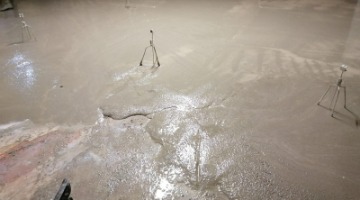Self levelling mortar
Hydraulic mortar by resistance or dosage. Able to flow and cover any part or corner of the surface to be levelled, solely by the action of its own weight, without causing segregation. Its manufacture involves cement, siliceous or calcareous sands centred on an established spindle, water, fibres and specific additives. It is transported to the site in a concrete mixer lorry, the material is placed by means of a pumping system and is applied by specialised personnel.
Additional information
Documents
Field of application
- Among the main applications of this mortar, it is worth highlighting its use as regulation bases, screeds and levelling of surfaces.
- Compatible with thermal and acoustic insulation.
- Suitable for the restoration of old flooring or flooring in poor condition.
- We have different more specific formulations of self-levelling mortar depending on its use:– C12: Regulation bases for floating parquet, wood, ceramic or stone products– C20: glued parquet, radiant floors, carpeting, vinyl flooring, microcement and glued flooring that require greater resistance– C25: Compression layers in floor slab restoration.
Advantages
- Easy to apply.
- Daily coverage: 400 m2.
- Treading time: 48 h.
- Absence of stocks of cement or sand bags on site.
- No need for cranes and forklifts.
- Controlled dosage.
- Optimal paving planimetry.
- Greater resistance.
- 100% use of the material.
- As it is pumped, no waste is generated on site (pallets, plastics, etc.).
- Reduction of noise levels.
Application system
- Cleaning of the substrate before laying the mortar: elimination of curing products or release agents, dust, paints, oils.
- Placement of level reference points using laser technology.
- Placement of a perimeter plinth.
- Pumping and spreading of mortar.
- Compaction and de-aeration of the pavement.
- Removal of the surface film and dust with a manual brush (broom).
- Drying time depending on the humidity of the base, determined by the nature of the material to be laid and the thickness of the application.
- In case of using adhesives or glues, the mortar surface must be brushed with a machine or a brush with spikes when applying the final coating.
- Remove any dust, grease, oil, etc. from work carried out after the flooring has been laid.
- Avoid overloading the flooring at an early age.
Technical characteristics
| Compressive strength UNE-EN 13813 | CLASS C12 | CLASS C20 | CLASS C25 |
|---|---|---|---|
| Maximum aggregate size | 4mm | 4mm | 4mm |
| Consistency UNE-EN 1015-3 | 200-260mm | 200-260mm | 170-200mm |
| Fresh density | 1,90 +/- 0,1Kg/l | 2,00 +/- 0,1Kg/l | 2,00 +/- 0,1Kg/l |
| Hardened density | 1,85 +/- 0,1Kg/l | 1,90 +/- 0,1Kg/l | 2,00 +/- 0,1Kg/l |
| Adhesion (with adhesives type Ci) | 0,65 N/mm2 | – | – |
| Direct adhesion to the pavement | 0,20-0,40 N/mm2 – – 0,20-0,40 N/mm2 | 0,20-0,40 N/mm2 – – 0,20-0,40 N/mm2 | 0,35-0,50 N/mm2 |
| Flexural strength Mort.self-levelling | F3 | F5 | F7 |
| Shrinkage at 23ºC and 55% RH | 7 days: -0,325 mm/m 28 days: -0,800 mm/m | 7 days: -0,325 mm/m 28 days: -0,800 mm/m | 7 days: -0,325 mm/m 28 days: -0,800 mm/m |
| Humidity (in standard conditions, at 20ºC and 45% H) | 21 days: 5% 28 days: <3% 21 days: 5% 28 days: <3% 21 days: 5% 28 days: <5 | 21 days: 5% 28 days: <3% 21 days: 5% 28 days: <3% 28 days: <3% 21 days: 5% 28 days: <5 | 21 days: 5% 28 days: <3% * 21 days: 5% 28 days: <3% 21 days: 5% 28 days: <3 |
* Liquid consistency can only be obtained if superplasticisers are used (EHE 31.5).
Share this product
Naturaleza
Fresco
Suministro
With concrete mixer truck
Share this product
 España
España  Croacia
Croacia  Turquía
Turquía  Argentina
Argentina  México
México  Colombia
Colombia  Uruguay
Uruguay  Bolivia
Bolivia  Bangladesh
Bangladesh  Túnez
Túnez 


